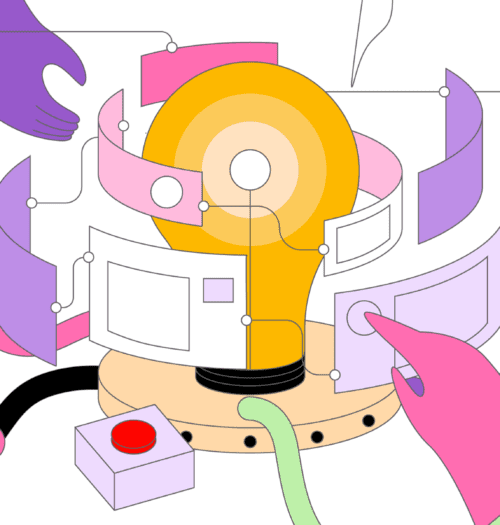🎁 Free 30-day publishing fees on Pay-As-You-GO. Get 15% off when recruiting from the UserQ Panel, with code HELLO15

When the world’s most popular streaming platform: Netflix, entered India, it quickly realised that streaming isn’t easy thanks to spotty internet service providers. Through research, Netflix had to pivot its strategy to appeal to the masses through a native app download feature that helped Indian residents get their daily dose of entertainment seamlessly. Over the years, it made several improvements to the download feature to make offline content-binging a breeze. So, Netflix is an excellent example of the value of baking user research into product development strategies.
If you’re a product manager or researcher, you’re no stranger to how most organisations adopt user research in the usability testing stage. Whether you’re launching new UX features or expanding operations that will cater to a new demographic, like Netflix, relying on user research to understand consumer behaviour and then building a strategy to address it – rather than the other way around – is often the difference between a loved brand and one that’s easily forgotten.
But how can you ensure that your user research is a proactive experiment in customer problem-solving at every stage of the development process?
Enter concept testing: a powerful tool to validate your ideas before you go off and build the final product in the wrong way.
It’s a strategic way to reduce risk, save costs on late change requests, and – the juiciest bit – secure stakeholder buy-in.
Read on to know how.
What is concept testing, and how can it give you a head start?
Concept testing is a research method of collecting user feedback on an idea that hasn’t yet been fully designed. This process gives an early insight into whether or not your proposed solution has a potential market. It’s an open learning process where you can consistently engage with the target audience to get their reactions to product development as it happens – before investing heavily in high-fidelity artefacts and designs.
World-renowned researcher Jared Spool boldly expressed that, in an ideal world, UX research would be in charge. While we’re not quite there yet, concept testing gives researchers a seat at the table and a voice in the critical decision-making process of product development strategy.
It’s like a crystal ball that reveals your strategy’s challenges, biases, and potential pitfalls. And once that feedback surfaces, teams can dive deeper. Developers, PMs and designers will have much better clarity as they begin each design sprint, spike, and epic.
Regularly engaging with users through concept testing will put you in a cycle of learning from your audience and refining your prototype to meet their needs. The resultant improvements from concept testing questions will deeply inform your final measurement method, such as usability testing. At this stage, employing a tool such as prototype testing, for example, will showcase how the end product is a truly customer-centric design.
Becoming customer-centric: integrating concept testing UX throughout the product lifespan
Concept development and testing have been around for a long time but only recently gained extra traction – and for good reason! The practice of integrating more concept research shows a positive interest in learning about customers and building strategies around their perspective.
Continuous concept testing throughout the product development cycle is a great way to engage stakeholders and final users – it gives them a front-row seat to the design evolution process.
‘‘The beauty of concept testing is that it can be done during any stage of the product design process, whether at the beginning to test a new product concept altogether or at a later stage, to test out a new idea for an existing product.’’
-Team UserQ
Carrying out design sprints of concept development and testing could involve research during the discovery and ideation stage – where customers are first introduced to your thinking – the results of which would lead to some low or mid-fidelity prototypes in the design stage that’ll generate more reactions. This middle stage could warrant returning to the drawing board and initiating more concept tests for refinement.
Lastly, the prototype that emerges from concept testing insights will undergo usability testing. Plus, concept testing can be leveraged to maximum benefit at the final stage to gauge the customer’s reactions to promotional designs/ads being built for the product launch.
When rolled out, products are intuitively designed to suit the user’s needs and are well worth the investment made by the company.
Quantitative or qualitative? What’s the best concept testing research methodology?
There’s no fixed way of designing a customer-first product, but combining both is a good way forward. If you’re in the initial planning stages, teasing out your idea through remote unmoderated tools like surveys or a preference test is an excellent way to collect valuable quantitative research. This data can be presented internally to stakeholders for buy-in, and the project gets a green light.
Follow this up with qualitative research through focus groups, or interviews to gain deep reasoning that delivers perspective – and empower the team with actionable insights on further product concept testing.
Hit the ground running with these concept testing research tools:
1. Monadic testing
This method focuses on retrieving feedback for a single product concept. The upside is that users can put their entire focus on sharing insights solely on one idea – without any respondent fatigue or bias influenced by other concepts. This testing method is ideal for in-depth learning about an isolated product feature and the user’s broader opinions.
However, Monadic testing requires a larger sample size, and considering that most concept testing happens on the low-fidelity level, it might be wise to consider it when you’ve got a more fleshed-out mock-up in place.
2. Sequential monadic testing
As the name suggests, this method shows users multiple concepts – one at a time in a random sequence. Users are asked the same follow-up questions after each idea, and you must compare responses to analyse the best-performing concept.
It’s important to note that this method can result in fatigue so it’s advisable to limit the number of concepts.
3. Comparative testing or preference testing
This method involves a side-by-side showcase of two or more concepts. It’s a great way of discerning participant preference, where they are asked to pick the solution that stands out to them. However, it can be complex to build, as some artefacts might stand out over others and sway user sentiment.
Once your comparative test shows which concept is more engaging to users, a good practice would be to refine it and present the more polished version to users through a monadic test – allowing you to unearth valuable insights.
4. Protomonadic testing
This explores the best of both comparative and sequential-monadic testing, where users are shown multiple concepts separately and sequentially to gather first impressions. Using questions with rating scales in this type of test is a good way to quantify their reactions.
Protomonadic testing involves showcasing a prototype instead of a low-fidelity concept and might be best suited for gaining feedback on high-fidelity mock-ups.
5. Interviews and focus groups:
This in-depth qualitative analysis can power your concept with rich insights. Robust interviews will cover high-level areas through concept testing questions and dig beneath the surface to understand the following:
Do users really struggle in this area?
Is there an unmet need that this concept will aim to resolve?
How are users currently navigating the problem?
Is this problem due to a lack of user awareness about existing features?
What tools from competitor brands are users using in this area?
6. Surveys and questionnaires:
A good way of obtaining quantitative feedback in the early stages and can serve as a strong argument that a market exists for your product ideas. Using the data you retrieve from surveys carried out in the initial stages can be a reliable statistic to get stakeholder buy-in.
Depending on your objectives, tools such as the Prototype test or the 5-second test are great to test user sentiment.
Concept testing use cases: make research your ally
Strategising for product development
Identifying what product to develop is as critical as knowing when it’s ready for dispatch. Running product concept testing research before designing and launching is a best practice. The insights from this initial stage can be synthesised into themes and challenges that customers need solutions to.
Testing a logo
Your logo is the single most identifiable asset of your brand. It holds plenty of power to influence and grab attention. Designing one that tugs at your customer’s heartstrings is vital to attracting launch success. Running concept tests to gauge reactions will help you know what it would take to exceed your customer’s expectations.
Introducing offers and new pricing
Whether planning for a big end-of-season sale (EOSS) or building a new price list of your best selling products, concept testing it with audiences first will clarify which elements stick – and which ones throw them off. This exercise reveals what parameters sway the customer’s buying decisions – pure gold for further idea maturation.
Testing ads for promotional campaigns
Organisations launch new products through advertising campaigns that create consumer buzz. An effective way of ensuring you meet your KPIs is using concept testing to understand if your campaign assets will generate engagement. Testing varied versions of website ads, social media ads, campaign imagery, and key visual banners will convey what gets users to click or skip – informing your promotional campaign strategy.
Designing a website or app homepage
Whether you’re a D2C eCommerce retailer or a B2B SaaS company, an intuitive homepage can be all the difference between high traffic and pin-drop silence. Baking in UX is a no-brainer, but incorporating it through research from concept testing is sensible. Your spectrum of customers will shine a spotlight on subtleties and nuances that might be overseen, giving your developers, PMs, and designers some quick targets to hit.
Best practices to adopt and challenges to watch out for
Be clear about your validation goals
Working with clear objectives in mind will help you evaluate whether a concept has the potential and whether to allocate time, talent, and investment to it. Undefined goals will have you going around in circles and make results hard to interpret. Identifying a minimum or maximum level of affinity is a good place to start.
Beware of bias
Concept development and testing will help you identify bias within an idea, but asking the right questions – free of bias – or leading the customer to an intended conclusion is imperative for achieving actionable insights.
Work on designing the test
Populating concept tests with too many questions, concepts, or unclear language is a recipe for chaos. Pilot testing with a small internal focus group is a healthy approach to avoiding this.
Use fidelity to your advantage
Using concepts that have high-fidelity prototypes or designs can be misunderstood as a final product and not a concept. This might lead to participants sharing feedback on branding and copy – instead of on whether this artefact adds value to them in the first place. On the flip side, creating a very low-fidelity artefact might leave too much for assumption, leading to you over-explaining and potentially creating a bias in the respondent’s mind. Finding that perfect balance is critical.
When customers are shown concepts that aren’t final products, they’re more comfortable critiquing the idea and sharing feedback or elaborating more on their needs.
Don’t expect usability feedback
Prototypes generated for product concept testing must aim to learn if work is heading down the right path. Expecting feedback at this point on elements such as design, task completion rate, etc., will not add value.
Why you need to start concept testing
In the beginning, we discussed how streaming giant Netflix used research to inform product development when it set up shop in India. Countries like India – and particularly the UAE – are touted to sky-rocket in the next few years, with global players keen on tapping their super-economies. Localisation will play a significant role in this effort, alongside user research, to access critical cultural context. And concept testing is your superpower.
If you’re exploring ways to enter the MENA market, concept testing to access local insights is imperative.
Get started today with UserQ: MENA’s first remote testing tool that lets you validate designs in both Arabic and English. With a participant panel of over 10,000 users and a range of quantitative research tools, UserQ makes kick-starting your concept testing effort a lot easier.
Related Post

Best practices for conducting remote
In this guide, we’ll let you in on UserQ’s top tips and tricks to utilise our selection of remote user

Start, Grow, Lead: A Guide
A career in which you can make a real difference to the everyday lives of customers and clients alike is

Validating your prototype FAQs: advice,
Ready to validate your prototype with our easy-to-use prototype testing tool? Well, we’ve got some must-hear advice and support to
Subscribe to our
product newsletter!
Receive emails about UserQ updates, new features,
offers and latest trends.


